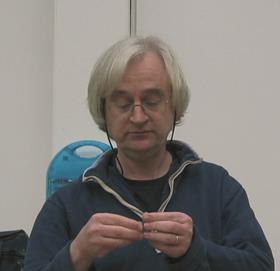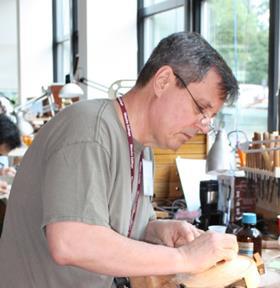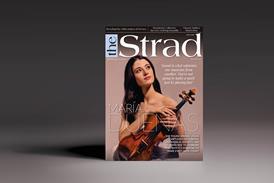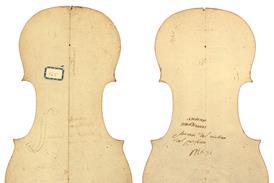A panel of luthiers give their thoughts on some unusual marks that have appeared on the surface of a violinist's instrument over the course of his playing career

The dilemma: Over the years, my bow frog has chipped bits of wood off the edge of myviolin when I’ve been playing (perhaps too enthusiastically!). Some of thechips are quite deep. Could this endanger my instrument in anyway, or is it just cosmetic damage? Will it affect the value of the instrument?
ALBERTO GIORDANO

The C-bout area is the part of the violin that suffers the most from the movements of players. The varnish, edges and corners are always at risk of being hit or spoiled. In some cases this can be a result of the violinist’s enthusiasm, whereas in others it can be caused by a difficult relationship between the instrument and the player. Maybe the proportions of the violin itself are uncomfortable: a wide C-bout, high arching and/or an incorrect neck setting, for instance, can dramatically reduce the space for the bowing action between the string and the edges of the belly. This causes the bow hair to come into contact with the wood of the edge – as well as a sense of frustration in the player.
In this case, it is a good idea to take the violin for a check-up in order to see if the neck setting, the overhang and the fingerboard projection on the mensur are set properly. The correct balance of these proportions is also fundamental to achieving the best tone quality. As for nicks and chips, unfortunately this kind of damage can sometimes be more than ‘cosmetic’. Light marks on the edges are a minor problem: they can be hidden with wood filler and good retouch work, but deeper nicks and chips can be detrimental to the general look of the instrument. Looking at the edges, for example, the marks on the convex side could be considered minor damage, but those in the inner scoop and purfling will be more difficult to repair. In general, a spruce edge can be restored with new wood, but inserting new purfling is a much more difficult task.
Alberto Giordano is a luthier based in Genoa, Italy
JOHN DILWORTH

Sometimes the only answer to a player’s question ‘How can I stop this happening?’ is ‘Practise.’ If your bow is constantly clattering against the corners or C-bout edges, it may be simply because your playing is indeed too enthusiastic. But there could be issues with your violin. A high-arched Stainer-type instrument with small corners will always be less vulnerable to bow damage than a broad, flat Stradivari model.
Damage is always harmful to the health and value of a violin in some way, and of course best avoided, even if it is cosmetic up to a point. Small dinks and bumps, as they appear in this photo, can be put right fairly easily and if caught in time they should not harm the value of the violin. Some discreet filling and retouching will restore the condition of your instrument and also stop the damage getting worse, of course.
Once the edge damage reaches the purfling, however, or the rib end is knocked back to the corner-block inside, it becomes a complex task to heal things properly and there is a real danger of structural deterioration. One important function of the purfling is to act as a sort of crash barrier against this sort of thing. So get your violin checked over properly to make sure that the neck and bridge are of sufficient height to give the bow adequate clearance. If everything is OK, do your best to keep your bow under control (sorry – this isn’t something I can say easily!), and finally, keep an eye on any damage and make sure a repairer takes care of it before it goes too far.
John Dilworth is a luthier based in Twickenham, UK, and formerly The Strad’s lutherie consultant
CHRISTOPHER GERMAIN

As you noted, it’s possible to damage the C-bouts and corners of the top of your instrument by hitting the edge with your bow frog or head. There are two main factors that can lead to excessive damage and edge wear – the width of the instrument’s C-bouts and the angle and tilt of the instrument’s neck. In addition, some stringed instruments have excessively long corners, which increase the possibility of damage from a wayward bow stroke.
Although this type of damage is mainly cosmetic, it can greatly affect the value of the instrument and can be extremely costly to repair properly. It’s best to have your instrument checked over by a qualified restorer who can see if the neck angle and tilt are adequate to prevent damage from the bow.
A device called the ‘C-Clip’ is also available, which can help to prevent damage. This is a plastic covering that can be attached to the C-bout and corners. It can be easily attached or removed, and if the bow happens to hit the C-bout area, the C-Clip prevents the frog from chipping the wood and varnish.
Accidents happen, but in this case much of the damage, aggravation and cost involved with edge and corner repairs is preventable, so I’d advise you to take these steps in order to protect your instrument.
Christopher Germain, based in Philadelphia, and a former president of the Violin Society of America
SHEM MACKEY

The belly edge of a violin is especially vulnerable. While the back of the instrument is made from hard maple, the front is made from spruce – a much softer wood. Spruce is the chosen soundboard wood for almost all stringed instruments because of its acoustic properties, but it does have a tendency to split and splinter, particularly along its well-defined grain lines. The darker lines in the wood are the sections laid down in the cold winter months and are extremely hard and dense. The light-coloured intermediate wood is the faster summer growth, and is extremely soft.
The corner damage shown in the photo is minimal but not entirely cosmetic. Wood has been lost from the upper edge, reaching slightly inside the bee-sting of the purfling, and will need to be replaced with a matching piece or pieces. This replacement piece should match in terms of grain width, growth ring thickness, alignment of cut and refraction.
This damage should not detrimentally affect the value of the instrument but I would advise you to have it fixed as soon as possible. Small splintered areas can snag in clothing and quickly turn into a bigger problem. It is always good practice to retain any pieces that break off an instrument and have them re-attached as soon as possible, while the broken faces are still fresh, clean and unworn. It goes without saying that such work should be placed in the hands of an experienced repairer.
Additionally, the ribs have been dented by the bow. The varnish is still intact and there has been no splintering of the harder maple, but it may still require attention and some infilling.
Shem Mackey makes early violins and violas da gamba as well as early bows. He is based in Ramsgate, UK
This article was first published in The Strad's October 2014 issue
Read: Ask the Experts: how to guarantee a violin's resaleability
Read: Ask the Experts: how to fix a wobbling bow frog
Discover more lutherie articles here
An exclusive range of instrument making posters, books, calendars and information products published by and directly for sale from The Strad.
The Strad’s exclusive instrument posters, most with actual-size photos depicting every nuance of the instrument. Our posters are used by luthiers across the world as models for their own instruments, thanks to the detailed outlines and measurements on the back.
The number one source for a range of books covering making and stringed instruments with commentaries from today’s top instrument experts.
American collector David L. Fulton amassed one of the 20th century’s finest collections of stringed instruments. This year’s calendar pays tribute to some of these priceless treasures, including Yehudi Menuhin’s celebrated ‘Lord Wilton’ Guarneri, the Carlo Bergonzi once played by Fritz Kreisler, and four instruments by Antonio Stradivari.
































No comments yet